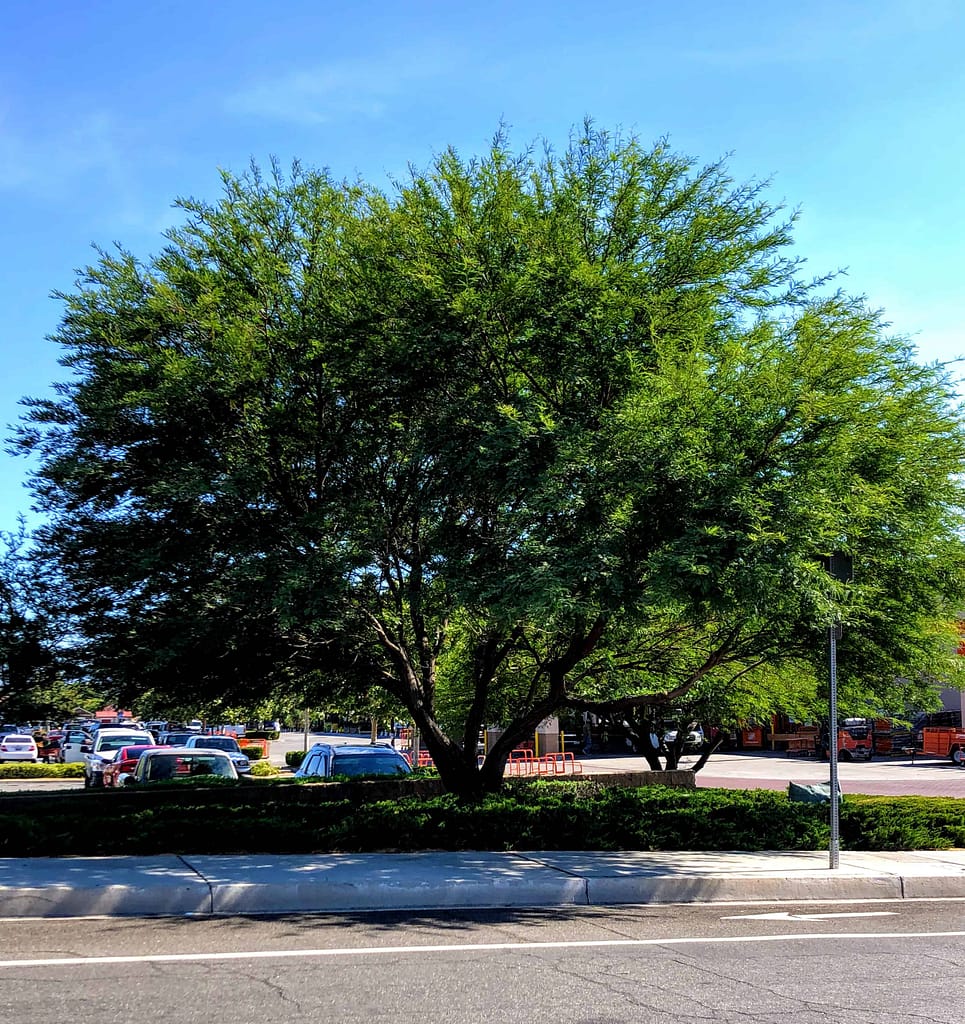
Mesquite trees are quickly becoming a hot item here in the Mojave Desert. Mesquites grow quickly when given water, tolerate drought, and have a large arching growth habit that provides shade to a large area. On top of that, the leaves are small and virtually disappear when fall comes leaving almost no cleanup. For a comparison of the Chilean Mesquite vs other shade trees head here: https://www.natesnursery.com/shade-trees-high-desert/
Varieties & Cultivars
Honey Mesquite – Prosopis Glandulosa
Screwbean Mesquite – Prosopis Pubescens
Velvet Mesquite – Prosopis Velutina
Chilean Mesquite – Prosopis Chilensis
The first 3 listed mesquite trees are native to the southwestern deserts, where the Chilean Mesquite is native to, you guessed it….. South America. Most nurseries will carry the Chilean Mesquite as it tends to be sold more often due to it being thornless. Honey Mesquite trees are possible to find, but require a bit of effort as they are not always available or available in all sizes. I haven’t seen Screwbean Mesquite or Velvet Mesquite for sale here in Southern California (though I haven’t tried all that hard). For a more in depth list of difference and what makes each mesquite tree special you can read this article.
Why Plant A Mesquite?
Mesquite trees have an amazing tolerance for drought. If watered correctly they can become completely self sufficient in terms of water, but they grow much quicker when irrigated regularly. Fast growing shade is the main reason mesquite trees are planted, with the added benefit of low water needs. They provide a nice shape that naturally forms an umbrella shape that compliments any landscape.
Complaints About Mesquites
- Seed pods are something people don’t tend to like about mesquite trees
- Seed pods are “messy” and some find them “unsightly”
- Several varieties have thorns, though they fall off as the branch ages.
- Pruning through the early years is recommended with our high winds, and some don’t like that added maintenance
- They can be toppled by wind if incorrectly cared for when young. Proper pruning and watering help to avoid this problem
Misinformation About Mesquites
One property of mesquite trees that is frequently thrown around is that they have a really deep taproot. While the deepest taproot recorded has reached around 140′ deep, the commonly found depth of mesquite tree taproots in urban environments is closer to 6′. That means that you can’t just plant one and never water it after the first 2 years and expect amazing growth as the taproot reaches the water table because that doesn’t happen in the compacted soil of urban environments.
Not all Chilean Mesquite trees are 100% thornless. Mesquite trees hybridize with other species and this causes the seeds to not produce the exact same tree. This results in some Chilean Mesquites having a small amount of thorns, an amount of small thorns (instead of large ones), or sometimes a lot of thorns. Perfect replication of Chilean Mesquite trees can be done by propagation through cuttings, but it is a less common way of production for these trees within the nursery industry due to the difficulty of producing a high success rate.
Right Tree, Right Place
To avoid problems of varying degrees, it is recommended these trees are NOT planted in the following places:
- Under power or utility lines
- Within 10′ of your home
- Within 30′ of your septic tank
Toxicity
While not toxic to humans or animals, mesquite trees can cause issues to animals when consumed in large quantities (upwards of 50% of their diet). For more info refer to the following articles:
- https://thehorse.com/132728/mesquite-tree-beans-toxic/
- https://www.wildflower.org/expert/show.php?id=5920
- https://corescholar.libraries.wright.edu/cgi/viewcontent.cgi?article=1043&context=jbm (Very thorough if you’re up for the read)
